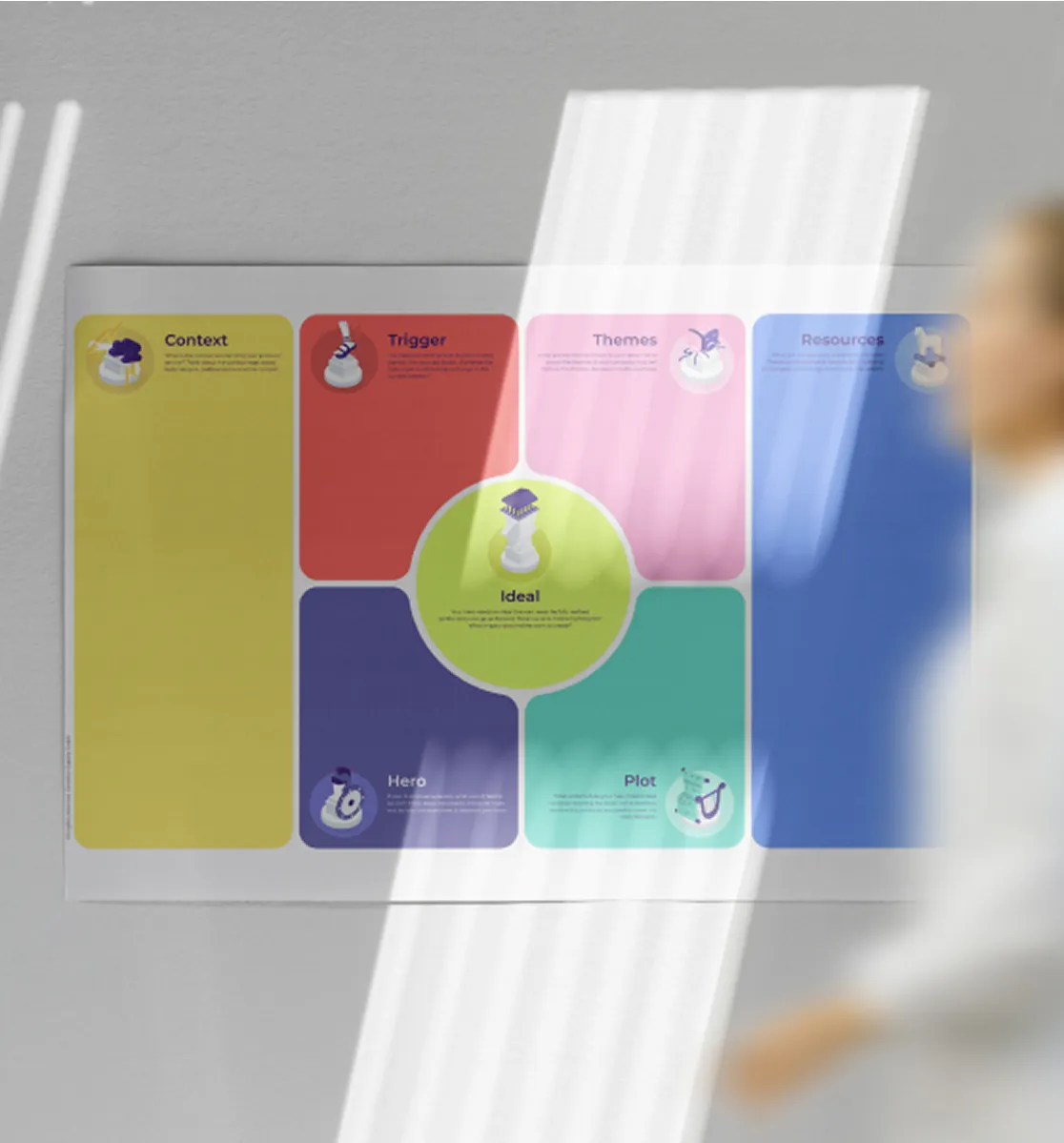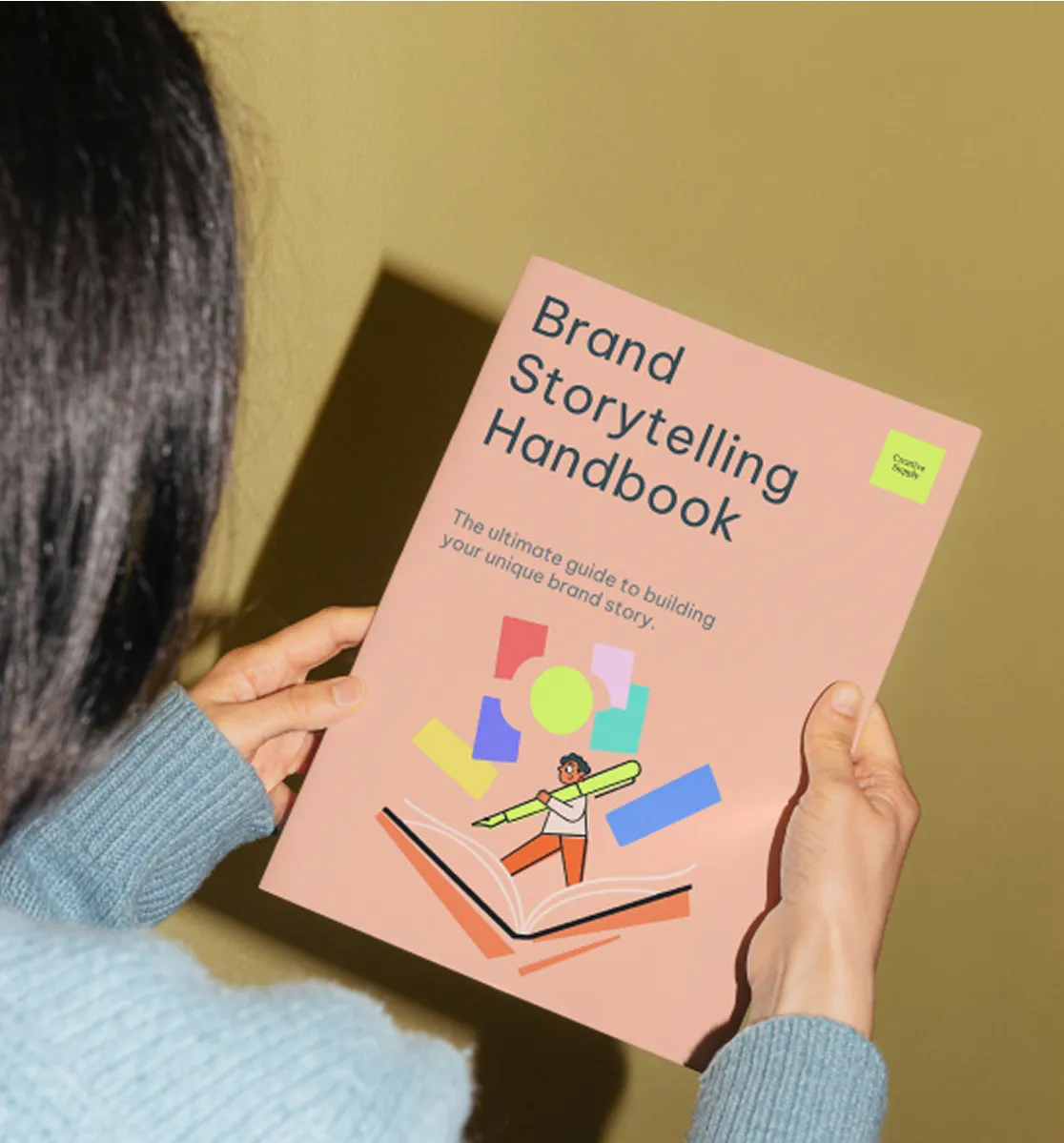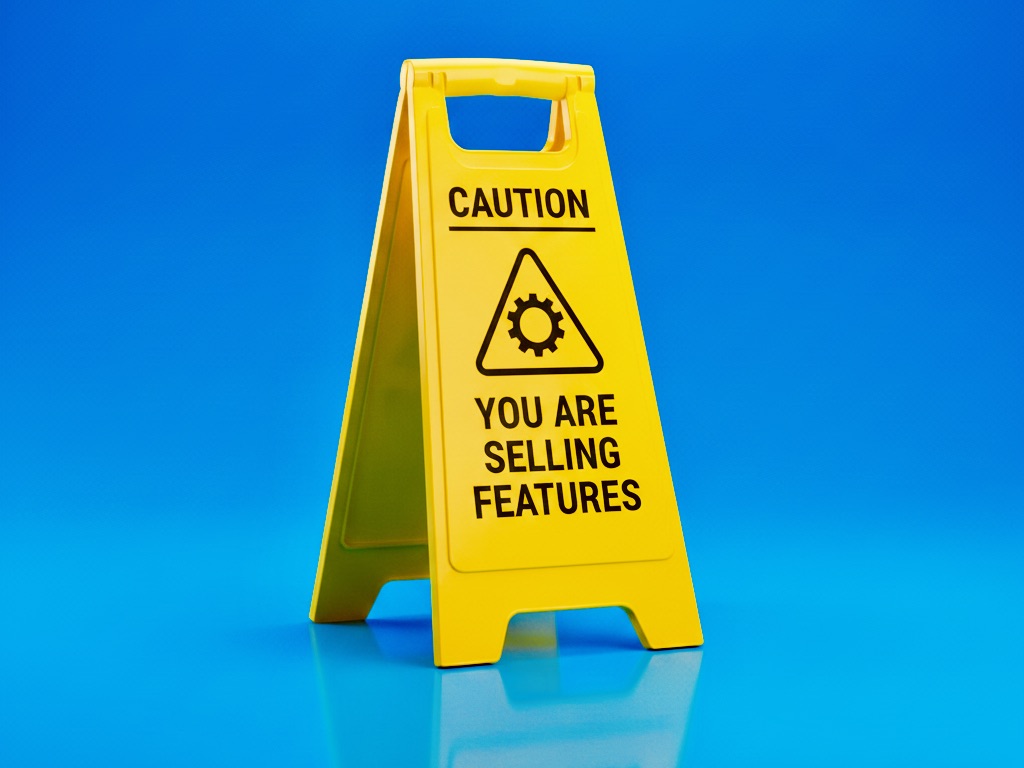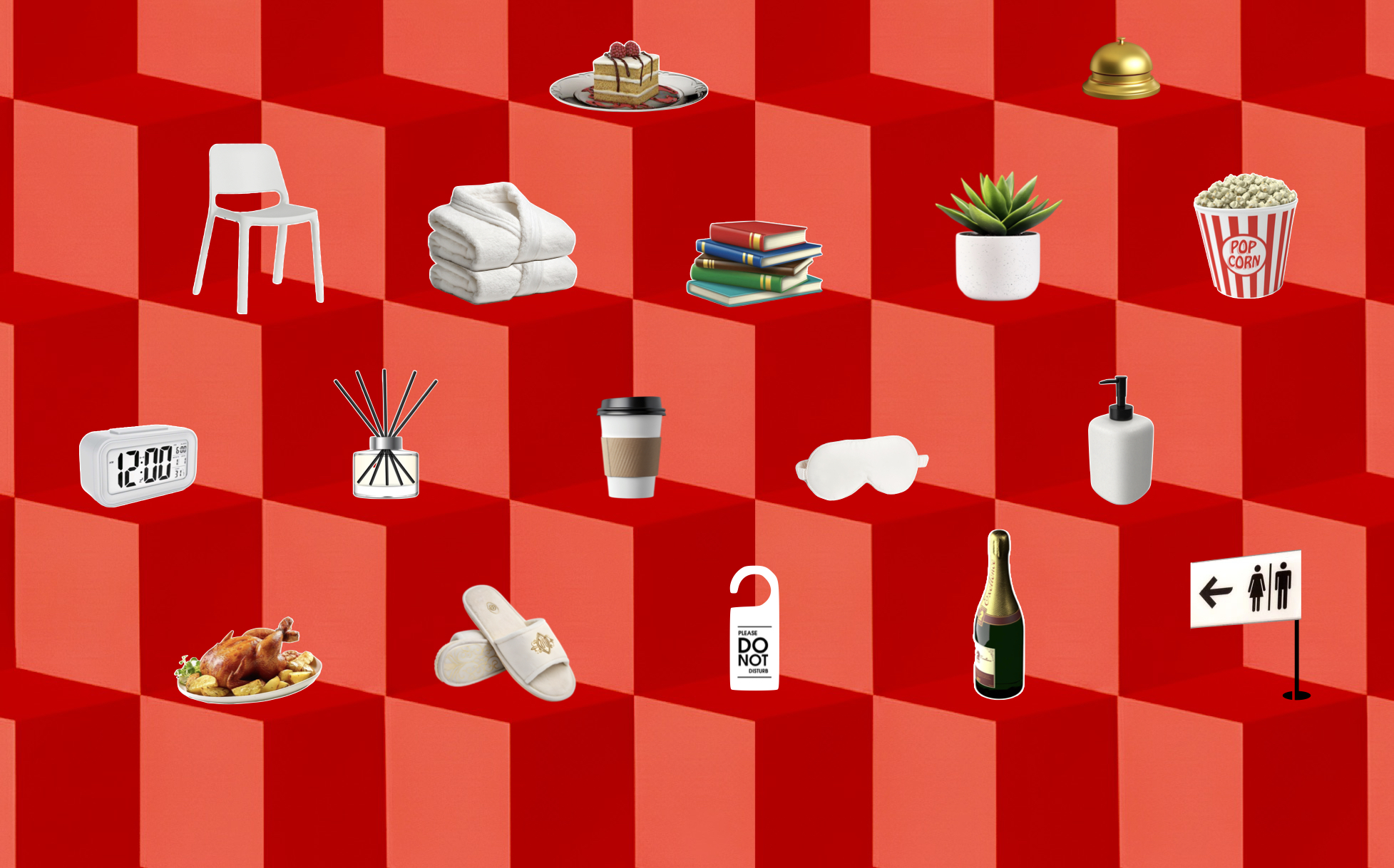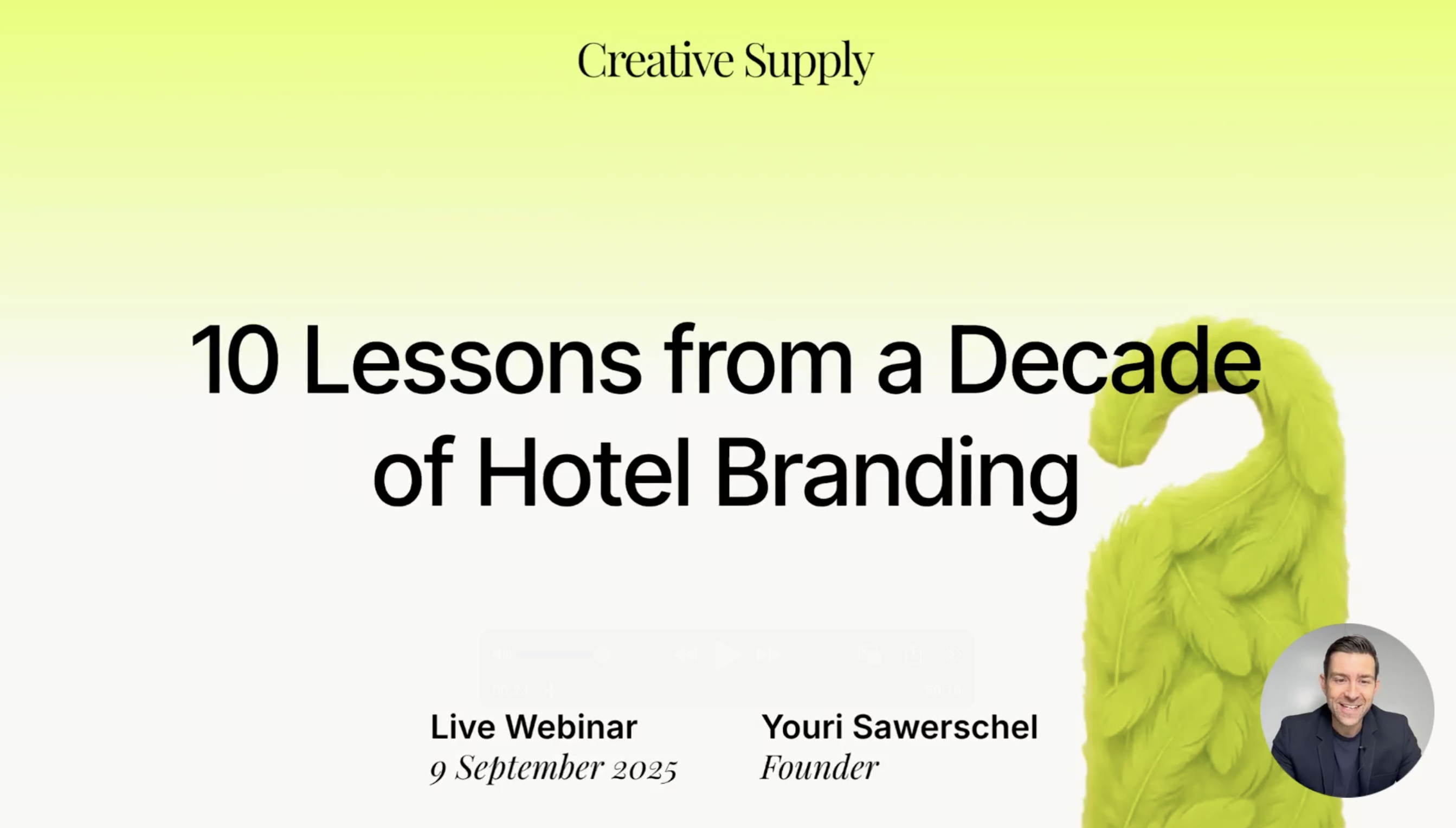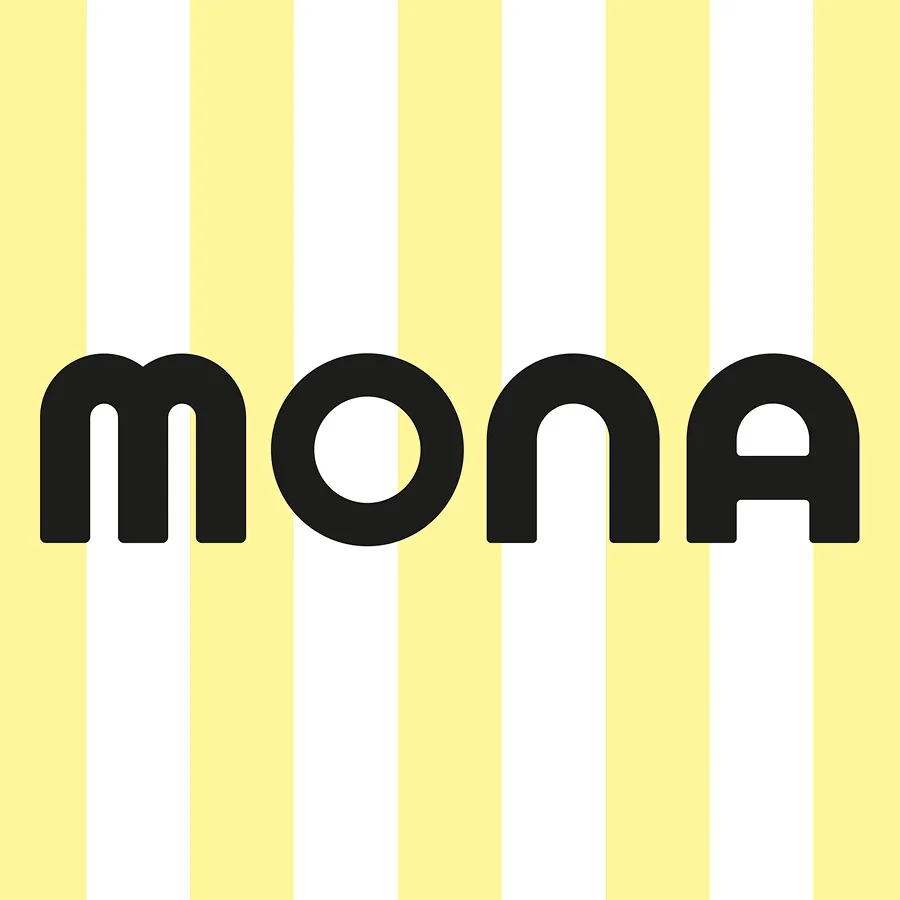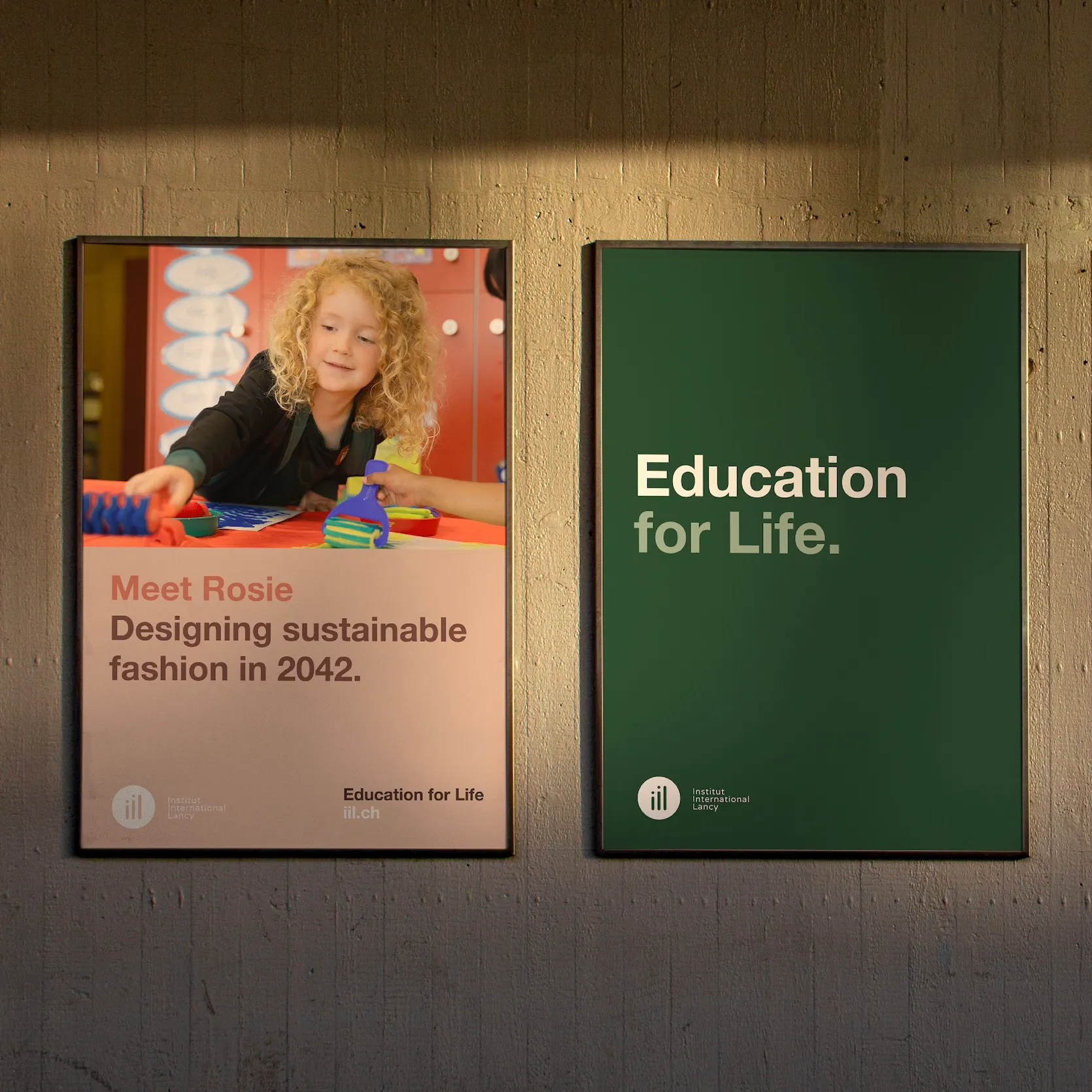How to Build a Brand Story Using the Brand Story Canvas
Discover our Brand Story Canvas — the essential tool to craft compelling brand stories that truly resonate. This guide will show you how to use it to define your organisation’s unique narrative and strengthen your branding initiatives.

What is a Brand Story?
Storytelling remains one of the most powerful tools in marketing. It can promote a car, inspire your employees, or sell hotel rooms. But what exactly is a "brand story" and how do you create one that stands out?
A brand story provides meaningful context to a product or service. It expresses an organisation’s vision, benefits, and values in a memorable and emotional way. A strong brand story cannot be replicated by competitors. It thus helps establish the role of a brand amid its competition, the market and the world at large.
Note that brand stories are often confused with advertising. However, they are not the same. To illustrate, advertising is to a brand story what a single episode is to a television series: the story begins but never truly ends. A strong brand story continually evolves and deepens.
What Makes Up a Brand Story?
Our Brand Story Canvas is a visual framework outlining the key elements of any brand story. It comprises 7 fundamental components:
- Context
- Trigger
- Themes
- Ideal
- Hero
- Plot
- Resources
All good brand stories can be broken down into these components. This model is universally applicable across industries and organisation sizes and is equally suitable for both product-level and corporate-level storytelling.
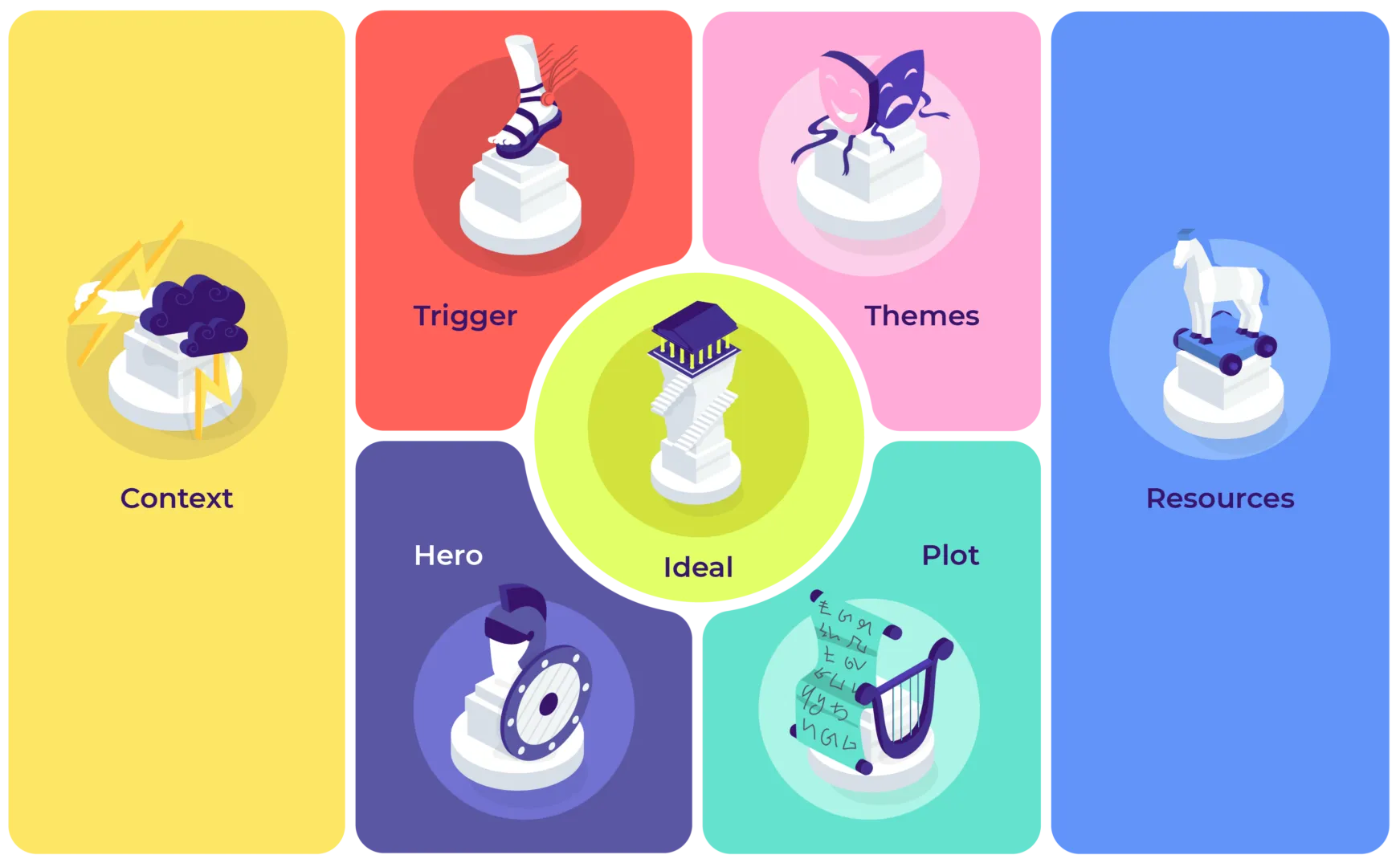
The 7 Components of a Brand Story
1. Context: Where the Story Takes Place
The context sets the stage for telling your brand story. It includes the external factors influencing your organisation — political, economic, social, and technological forces. Although these factors are external, you decide which context best serves your brand story.
For example, Nike may avoid the topic of child labour, while Tom’s might embrace it as part of their narrative.
2. Trigger: What Initiates the Story
The trigger is the belief, event, or situation that motivates your brand’s journey. It sets off the story and anchors it in the context.
Shinola, a leather goods company based in Detroit, tells a story triggered by a desire to "revive Detroit’s manufacturing legacy". Meanwhile, fashion brand Philipp Plein’s story ignites from the belief that "life is too short to be boring".
3. Hero: The Story’s Main Character
The hero is your brand personified — in other words, who your brand would be if it were a person and what characteristics it would possess. This may include nationality, personality traits, or values.
For instance, Mercedes-Benz embodies German elegance and elitism, whereas Mini represents English cheekiness and dynamism. In some cases, the hero can be the company’s founder or employees. Virgin, for example, draws its rebellious spirit from Richard Branson.
4. Ideal: The Hero’s Purpose
The ideal is the reason your brand exists. It unites all story elements and serves as the brand’s guiding vision. Importantly, a brand should never fully reach its ideal; if it did, the story would end.
Apple’s "Think Different" and Adidas’ "Impossible is Nothing" represent ideals that transcend products, trends, and generations. These ideals never fully materialise, which keeps their stories alive.
5. Plot: How the Hero Pursues the Ideal
The plot details the actions taken to achieve the ideal.
Red Bull, for example, embodies the ideal "to give you wings", symbolising an energetic lifestyle. Its plot involves organising events from music festivals to extreme sports rather than focusing solely on the energy drink itself. Similarly, eyewear company Warby Parker pursues its ideal of "creating an alternative" by offering high-quality glasses at affordable prices, combined with a convenient home try-on service.
6. Themes: The Story’s Dominant Ideas
Themes are the dominant ideas your brand "owns" in the minds of your audience. They also form the basis of content creation.
Moleskine owns the theme of "artist legacy", while Puma is associated with "speed". Freeletics, a fitness app, focuses on themes such as healthy living, personal strength, and urban lifestyle, reflecting its ideal of helping users become the best version of themselves.
7. Resources: The Assets Available to the Hero
Resources include everything your brand possesses to pursue its ideal. These resources should be unique and distinctive to your organisation.
Tangible resources may include people, land, factories, or buildings — for example, the skilled artisans at Hermès’ Paris atelier. Intangible resources could be knowledge, experience, or reputation, such as Coca-Cola’s secret recipe or Harvard’s MBA case studies.
How to Create a Brand Story with the Brand Story Canvas
Start by brainstorming ideas for the context on the left side of the canvas, then work rightwards through each component until you reach resources. Populate each cell with as many relevant points as possible.
Once complete, review the entire canvas, refine by adding, removing, or adjusting elements to build a coherent, authentic narrative that reflects your organisation’s essence.
We trust this introduction to the Brand Story Canvas will assist you in developing a powerful brand story.
Download the Brand Story Canvas in high quality printable format to start crafting your unique narrative today.
Download the Brand Storytelling Handbook, a comprehensive guide featuring the Brand Story Canvas and numerous storytelling examples.
Ready to Transform Your Brand Story?
Whether you’re launching a new brand or revitalising an existing one, our tailored approach ensures your story is authentic, differentiated, and impactful.
At Creative Supply, we specialise in helping organisations craft powerful brand narratives that cut through the noise, captivate audiences, and deliver lasting business growth.
👉 Contact us to discuss how we can unlock your brand’s full storytelling potential.
How to Build a Brand Story Using the Brand Story Canvas

What is a Brand Story?
Storytelling remains one of the most powerful tools in marketing. It can promote a car, inspire your employees, or sell hotel rooms. But what exactly is a "brand story" and how do you create one that stands out?
A brand story provides meaningful context to a product or service. It expresses an organisation’s vision, benefits, and values in a memorable and emotional way. A strong brand story cannot be replicated by competitors. It thus helps establish the role of a brand amid its competition, the market and the world at large.
Note that brand stories are often confused with advertising. However, they are not the same. To illustrate, advertising is to a brand story what a single episode is to a television series: the story begins but never truly ends. A strong brand story continually evolves and deepens.
What Makes Up a Brand Story?
Our Brand Story Canvas is a visual framework outlining the key elements of any brand story. It comprises 7 fundamental components:
- Context
- Trigger
- Themes
- Ideal
- Hero
- Plot
- Resources
All good brand stories can be broken down into these components. This model is universally applicable across industries and organisation sizes and is equally suitable for both product-level and corporate-level storytelling.

The 7 Components of a Brand Story
1. Context: Where the Story Takes Place
The context sets the stage for telling your brand story. It includes the external factors influencing your organisation — political, economic, social, and technological forces. Although these factors are external, you decide which context best serves your brand story.
For example, Nike may avoid the topic of child labour, while Tom’s might embrace it as part of their narrative.
2. Trigger: What Initiates the Story
The trigger is the belief, event, or situation that motivates your brand’s journey. It sets off the story and anchors it in the context.
Shinola, a leather goods company based in Detroit, tells a story triggered by a desire to "revive Detroit’s manufacturing legacy". Meanwhile, fashion brand Philipp Plein’s story ignites from the belief that "life is too short to be boring".
3. Hero: The Story’s Main Character
The hero is your brand personified — in other words, who your brand would be if it were a person and what characteristics it would possess. This may include nationality, personality traits, or values.
For instance, Mercedes-Benz embodies German elegance and elitism, whereas Mini represents English cheekiness and dynamism. In some cases, the hero can be the company’s founder or employees. Virgin, for example, draws its rebellious spirit from Richard Branson.
4. Ideal: The Hero’s Purpose
The ideal is the reason your brand exists. It unites all story elements and serves as the brand’s guiding vision. Importantly, a brand should never fully reach its ideal; if it did, the story would end.
Apple’s "Think Different" and Adidas’ "Impossible is Nothing" represent ideals that transcend products, trends, and generations. These ideals never fully materialise, which keeps their stories alive.
5. Plot: How the Hero Pursues the Ideal
The plot details the actions taken to achieve the ideal.
Red Bull, for example, embodies the ideal "to give you wings", symbolising an energetic lifestyle. Its plot involves organising events from music festivals to extreme sports rather than focusing solely on the energy drink itself. Similarly, eyewear company Warby Parker pursues its ideal of "creating an alternative" by offering high-quality glasses at affordable prices, combined with a convenient home try-on service.
6. Themes: The Story’s Dominant Ideas
Themes are the dominant ideas your brand "owns" in the minds of your audience. They also form the basis of content creation.
Moleskine owns the theme of "artist legacy", while Puma is associated with "speed". Freeletics, a fitness app, focuses on themes such as healthy living, personal strength, and urban lifestyle, reflecting its ideal of helping users become the best version of themselves.
7. Resources: The Assets Available to the Hero
Resources include everything your brand possesses to pursue its ideal. These resources should be unique and distinctive to your organisation.
Tangible resources may include people, land, factories, or buildings — for example, the skilled artisans at Hermès’ Paris atelier. Intangible resources could be knowledge, experience, or reputation, such as Coca-Cola’s secret recipe or Harvard’s MBA case studies.
How to Create a Brand Story with the Brand Story Canvas
Start by brainstorming ideas for the context on the left side of the canvas, then work rightwards through each component until you reach resources. Populate each cell with as many relevant points as possible.
Once complete, review the entire canvas, refine by adding, removing, or adjusting elements to build a coherent, authentic narrative that reflects your organisation’s essence.
We trust this introduction to the Brand Story Canvas will assist you in developing a powerful brand story.
Download the Brand Story Canvas in high quality printable format to start crafting your unique narrative today.
Download the Brand Storytelling Handbook, a comprehensive guide featuring the Brand Story Canvas and numerous storytelling examples.
Ready to Transform Your Brand Story?
Whether you’re launching a new brand or revitalising an existing one, our tailored approach ensures your story is authentic, differentiated, and impactful.
At Creative Supply, we specialise in helping organisations craft powerful brand narratives that cut through the noise, captivate audiences, and deliver lasting business growth.
👉 Contact us to discuss how we can unlock your brand’s full storytelling potential.


How to Build a Brand Story Using the Brand Story Canvas
Discover our Brand Story Canvas — the essential tool to craft compelling brand stories that truly resonate. This guide will show you how to use it to define your organisation’s unique narrative and strengthen your branding initiatives.
What is a Brand Story?
Storytelling remains one of the most powerful tools in marketing. It can promote a car, inspire your employees, or sell hotel rooms. But what exactly is a "brand story" and how do you create one that stands out?
A brand story provides meaningful context to a product or service. It expresses an organisation’s vision, benefits, and values in a memorable and emotional way. A strong brand story cannot be replicated by competitors. It thus helps establish the role of a brand amid its competition, the market and the world at large.
Note that brand stories are often confused with advertising. However, they are not the same. To illustrate, advertising is to a brand story what a single episode is to a television series: the story begins but never truly ends. A strong brand story continually evolves and deepens.
What Makes Up a Brand Story?
Our Brand Story Canvas is a visual framework outlining the key elements of any brand story. It comprises 7 fundamental components:
- Context
- Trigger
- Themes
- Ideal
- Hero
- Plot
- Resources
All good brand stories can be broken down into these components. This model is universally applicable across industries and organisation sizes and is equally suitable for both product-level and corporate-level storytelling.

The 7 Components of a Brand Story
1. Context: Where the Story Takes Place
The context sets the stage for telling your brand story. It includes the external factors influencing your organisation — political, economic, social, and technological forces. Although these factors are external, you decide which context best serves your brand story.
For example, Nike may avoid the topic of child labour, while Tom’s might embrace it as part of their narrative.
2. Trigger: What Initiates the Story
The trigger is the belief, event, or situation that motivates your brand’s journey. It sets off the story and anchors it in the context.
Shinola, a leather goods company based in Detroit, tells a story triggered by a desire to "revive Detroit’s manufacturing legacy". Meanwhile, fashion brand Philipp Plein’s story ignites from the belief that "life is too short to be boring".
3. Hero: The Story’s Main Character
The hero is your brand personified — in other words, who your brand would be if it were a person and what characteristics it would possess. This may include nationality, personality traits, or values.
For instance, Mercedes-Benz embodies German elegance and elitism, whereas Mini represents English cheekiness and dynamism. In some cases, the hero can be the company’s founder or employees. Virgin, for example, draws its rebellious spirit from Richard Branson.
4. Ideal: The Hero’s Purpose
The ideal is the reason your brand exists. It unites all story elements and serves as the brand’s guiding vision. Importantly, a brand should never fully reach its ideal; if it did, the story would end.
Apple’s "Think Different" and Adidas’ "Impossible is Nothing" represent ideals that transcend products, trends, and generations. These ideals never fully materialise, which keeps their stories alive.
5. Plot: How the Hero Pursues the Ideal
The plot details the actions taken to achieve the ideal.
Red Bull, for example, embodies the ideal "to give you wings", symbolising an energetic lifestyle. Its plot involves organising events from music festivals to extreme sports rather than focusing solely on the energy drink itself. Similarly, eyewear company Warby Parker pursues its ideal of "creating an alternative" by offering high-quality glasses at affordable prices, combined with a convenient home try-on service.
6. Themes: The Story’s Dominant Ideas
Themes are the dominant ideas your brand "owns" in the minds of your audience. They also form the basis of content creation.
Moleskine owns the theme of "artist legacy", while Puma is associated with "speed". Freeletics, a fitness app, focuses on themes such as healthy living, personal strength, and urban lifestyle, reflecting its ideal of helping users become the best version of themselves.
7. Resources: The Assets Available to the Hero
Resources include everything your brand possesses to pursue its ideal. These resources should be unique and distinctive to your organisation.
Tangible resources may include people, land, factories, or buildings — for example, the skilled artisans at Hermès’ Paris atelier. Intangible resources could be knowledge, experience, or reputation, such as Coca-Cola’s secret recipe or Harvard’s MBA case studies.
How to Create a Brand Story with the Brand Story Canvas
Start by brainstorming ideas for the context on the left side of the canvas, then work rightwards through each component until you reach resources. Populate each cell with as many relevant points as possible.
Once complete, review the entire canvas, refine by adding, removing, or adjusting elements to build a coherent, authentic narrative that reflects your organisation’s essence.
We trust this introduction to the Brand Story Canvas will assist you in developing a powerful brand story.
Download the Brand Story Canvas in high quality printable format to start crafting your unique narrative today.
Download the Brand Storytelling Handbook, a comprehensive guide featuring the Brand Story Canvas and numerous storytelling examples.
Ready to Transform Your Brand Story?
Whether you’re launching a new brand or revitalising an existing one, our tailored approach ensures your story is authentic, differentiated, and impactful.
At Creative Supply, we specialise in helping organisations craft powerful brand narratives that cut through the noise, captivate audiences, and deliver lasting business growth.
👉 Contact us to discuss how we can unlock your brand’s full storytelling potential.
